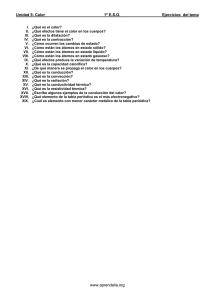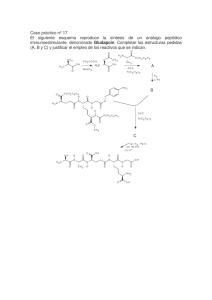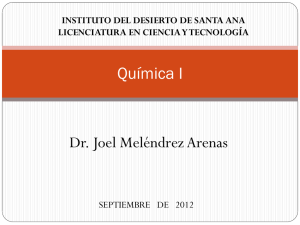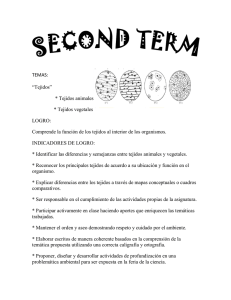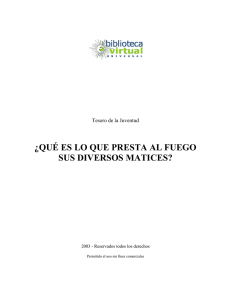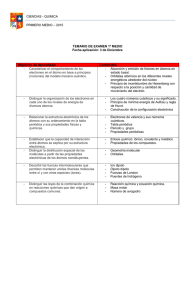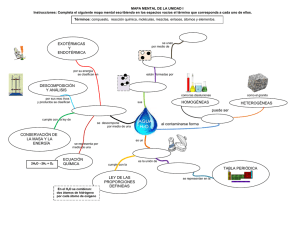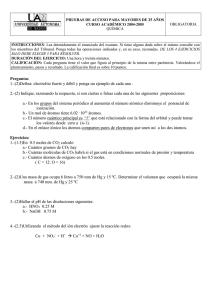Química
Anuncio
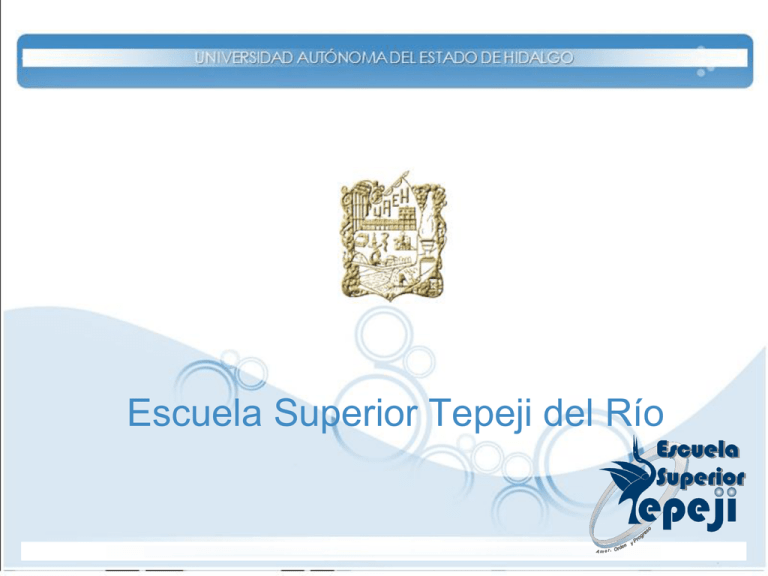
Escuela Superior Tepeji del Río Área Académica: Ingeniería Industrial Asignatura: Química Profesor(a): Q.F.B. Fabiola Olvera Neria Periodo: Julio-Diciembre 2011 Tema: Abstract Chemistry is one of the most important sciences, which helps the student to know the molecular estructure of the mater and how the mater suffer changes and transformatios in its electronic structure. On the other hand, the understanding of the chemical and physical properties of the compounds, allows the student to predict the results and behavior of the molecules under specific conditions and manipulate them in the laboratory in order to take advantage of this knowlegde to make innovatios . Keywords: Chemistry, mater, transformation, molecular structure. UNIDAD I Estructura atómica y tabla periódica “...no hay sino átomos y espacio, todo lo demás es solamente una opinión”. Democritus de Abdera Griegos: átomo, sin división Teoría atómica de Dalton (1808) 1. 2. Toda la materia está compuesta de partículas indivisibles llamadas átomos. Los átomos son indestructibles e inalterables. Las reacciones químicas incluyen la combinación de átomos, no la destrucción de átomos. 3. 4. Todos los átomos de un elemento son idénticos. Los átomos de diferentes elementos tienen diferentes propiedades. La combinación de átomos de diferentes elementos forman compuestos. Cuando los elementos reaccionan para formar compuestos, reaccionan en proporciones definidas y numéricamente enteras. Thomson: Demostró la existencia de los electrones dentro de los átomos. Esfera carga positivamente, con electrones incrustados (1897) Budín de pasas Chadwick: Descubrió el neutrón “Possible existence of a neutron”. Nature, p. 312 (Feb. 27, 1932) Rutherford: Demostró que los átomos no eran macizos. Poseían protones dentro del núcleo. Órbitas circulares. (1911) Bohr: Electrones alrededor del núcleo en niveles bien definidos, con un número limitado de ellos. (1913) Propiedades de las 3 partículas subatómicas Masa Nombre en gramos Carga en uma Símbolo eléctrica Electrón 9.1093897x10-28 g .0005485712 uma 1eProtón 1.674954x10-24 g 1.00727605 uma 1+ p+ o p Neutrón 1.674954 x10-24 1.008665uma 0 n DEMÓDRITO/ DALTON J. THOMSON RUTHERFORD/BOHR MECÁNICA CUÁNTICA J. Thomson John Dalton Ernest Rutherford Niels Bohr Tabla Periódica “Creador de la tabla periódica” D´mitri Mendeléyev Tabla periódica de D´mitri Mendeléyev (1891) DESCRIPCIÓN DE UN ÁTOMO NÚMERO ATÓMICO (Z): NÚMERO DE PROTONES CONTENIDOS EN EL NÚCLEO DE UN ÁTOMO. NÚMERO DE MASA (A): SUMA DE PROTONES MAS NEUTRONES Tabla Periódica actual Conceptos importantes… Isótopo: Átomos con el mismo número atómico, pero diferente número de masa Nombre Símbolo Protones Neutrones Número de Masa Abundancia natural Hidrógeno 1 1H 1 0 1 99.985% Deuterio 2 1H 1 1 2 0.015% Tritio 3 1H 1 2 3 trazas z A Conferencia Solvay de 1927. Niels Bohr se encuentra situado en la segunda fila, el primero por la derecha. Entre los participantes destacan Auguste Piccard, Albert Einstein, Marie Curie, Erwin Schrödinger, Wolfgang Pauli, Werner Heisenberg, Paul Dirac, Louis de Broglie y Max Planck. Configuración electrónica: listado distribución de los electrones alrededor del núcleo. Orbitales: zona donde es probable encontrar al electrón. Orbital Cantidad de ē s 2 p 6 d 10 f 14 de la Orbital s Orbital p Orbital d Configuración electrónica [He 1s 2 ] 2s Orbital Cantidad de ē [Ne] 10 s 2 [Ar] p 6 2p 3s 3p 18 3d 4s 4p[Kr] 36 4d 4f d 10 5s 5p[Xe] 54 5d 5f f 14 6s 6p[Rn] 86 6d 7s 7p s p d f UNIDAD II Nomenclatura Inorgánica UNIDAD III Nomenclatura orgánica 1. ENCONTRAR LA CADENA MÁS LARGA QUE CONTENGA LOS GRUPOS FUNCIONALES MÁS IMPORTANTES. REGLAS DE NOMENCLATURA 2. ASIGNAR A LOS GRUPOS FUNCIONALES MÁS IMPORTANTES EL NÚMERO MÁS PEQUEÑO. GRUPOS FUNCIONALES Ácidos carboxílicos Aminas Esteres Éteres Amidas Alquenos Nitrilos Alquinos Aldehídos Halogenuros Cetonas Nitro Alcoholes Alcanos HIDROCARBUROS CnH2n+2 ALCANOS LIGADURA SIMPLE LIGADURA DOBLE CnH2n+2 ALQUENOS LIGADURA TRIPLE CnH2n-2 ALQUIN OS 1 19 H3C H3C 1 8 1 1 7 6 1 9 1 7 8 1 3 1 1 2 1 1 6 5 4 0 CH3 CH3 5 2 4 3 H3C CH3 2,2,3,17,18-Pentametil-8,15 dietil-5,9-dieno-13-ino-12(2,3-dimetilbutil)-nonano. Éteres: R sencilla R sencilla H3C O O R´ Nombre Dimetil éter Etil metil éter O O CH3 R O Difenil éter O Isopropil metil éter Fenil isopropil éter Rcompleja R sencilla Nombre OH 1,2-Dihidroxi-3-eno-1-metoxibutano H2C O CH3 OH OH Cl 2-Cloro-4-isopropoxifenol O O H3C CH2 Ph 1,5-dieno-4-fenil-3-ciclopropoxi heptano R compleja R compleja HN 9 H3C 7 8 5 6 CH3 CH3 1 O 4 3 Nombre 2 CH2 NO 2 1,7-dieno-2-nitro-6,N-dimetil-5oxa-3-amino-nonano. GRUPOS FUNCIONALES R OH R- C ALCOHO LES R NITRILO S NH 2 R AMINAS R O ETERES N R´ X X= F, Cl, Br, I, HALOGENU ROS GRUPOS FUNCIONALES C R OH O C C R ÁCIDOS CARBOXÍLI COS R O O- R ESTERE S R NH2 AMIDAS O O O C C C R CETONA S R H ALDEHÍD OS R R ´ O GRUPO CARBONILO UNIDAD I. Estructura atómica y tabla periódica 1.- PRESENTACIÓN POWER POINT. 2.- SERIES DE EJERCICIOS. 3. LECTURAS: a) “Nieve Artificial”. Zumdahl, S. 2007. Química. 1ª edición. Grupo Editorial Patria. México. pp 22. b) “Hay oro en las plantas”. Zumdahl, S. 2007. Química. 1ª edición. Grupo Editorial Patria. México. pp 40. c) “Glenn Seaborg y la historia del seaborgio”. Brown, T. 2004. Química. La Ciencia Central. 9ª edición. Pearson Education. México. pp 49. UNIDAD II. Nomenclatura Inorgánica 1.- PRESENTACIÓN POWER POINT. 2.- SERIES DE EJERCICIOS. 3. LECTURAS: a) “El hassio cuadra perfecto”. Zumdahl, S. 2007. Química. 1ª edición. Grupo Editorial Patria. México. pp 57. b) “Hay oro en las plantas”. Zumdahl, S. 2007. Química. 1ª edición. Grupo Editorial Patria. México. pp 40. UNIDAD III. Nomenclatura orgánica 1.- PRESENTACIÓN POWER POINT. 2.- SERIES DE EJERCICIOS. UNIDAD IV. Reacciones Químicas 1.- SERIES DE EJERCICIOS 2.- LECTURAS: a) “FERTILIZANTES QUÍMICOS”. Chang, R. 1999. Química. Mc Graw Hill. México. pp 62-63. b) “UNA INDESEABLE REACCIÓN DE PRECIPITACIÓN”. Chang, R. 1999. Química. Mc Graw Hill. México. pp 82. UNIDAD V. Estequiometría: 1.- SERIES DE EJERCICIOS 2.- LECTURAS: a) “UNIDADES CRÍTICAS” . Zumdahl, S. 2007. Química. 1ª edición. Grupo Editorial Patria. México. pp8. UNIDAD VI. Enlaces químicos. 1.- PRESENTACIÓN POWER POINT. 2.- Lecturas: “Los explosivos y Alfred Nobel”. Brown, T. 2004. Química. La Ciencia Central. 9ª edición. Pearson Education. México. Pp 304. Bibliografía 1. 2. 3. 4. 5. . Chang, R. 1999. Química. Mc Graw Hill. México Brown, T. 2004. Química. La Ciencia Central. 9ª edición. Pearson Education. México. Zumdahl, S. 2007. Química. 1ª edición. Grupo Editorial Patria. México. McMurry, J. 2001. Química Orgánica. 5ª edición. International Thomson Editores. México. Harris, D. 1999. Análisis Químico Cuantitativo. 2ª edición. Editorial Reverté S.A. España.
